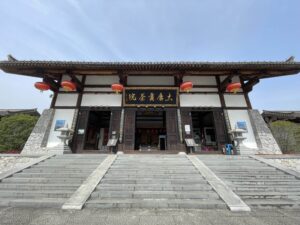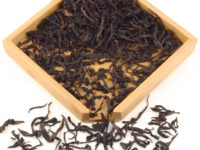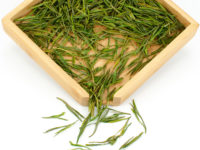Guzhu Zisun (Purple Bamboo Shoot)
Green Tea 2025
Guzhu Zisun (Purple Bamboo Shoot) green tea is grown in a natural bamboo forest. This handmade tea has a fresh and clean yet complex flavor and lingering sweet aftertaste. It possesses light notes of sugar snap pea under a wildflower aroma. Some of the early spring buds and leaves have a faint purple blush when fresh. This was the first tribute tea 1,200 years ago given exclusively to the emperor and his court.
- Tea Origin
- Changxing County, Huzhou City, Zhejiang Province, China
- Tea Bush
- Lao Cha Shu Quntizhong (Old Heirloom Tea Bush)
- Tea Maker
- Pei Hongfeng
- Harvest Time
- Early April
- Plucking Standard
- One bud, two leaves

Guzhu Zisun (Purple Bamboo Shoot) green tea was the first tribute tea made for the emperor’s court 1,200 years ago. It is traditionally handmade by tea master Pei Hongfeng, born in the late 1930s, who remains one of the rare female tea masters of her generation. She is highly respected as a master tea maker as well as a local community leader. Every spring, she helps support her community by hiring local women who cannot travel far for extra jobs or income to harvest the tea.
Guzhu Zisun (Purple Bamboo Shoot) green tea was the first tribute tea made for the emperor’s court 1,200 years ago. It is traditionally handmade by tea master Pei Hongfeng, who is now in her seventies and remains one of the rare female tea masters of her generation. She is highly respected as a master tea maker as well as a local community leader. Every spring, she helps support her community by hiring local women who cannot travel far for extra jobs or income to harvest the tea.
The heirloom cultivar tea bushes used to make this tea grow in the bamboo forest behind Pei Hongfeng’s house. The freshness from its natural growing environment is present in the tea.

These Guzhu Zisun tea bushes grow largely unattended in the bamboo forest. They are not uniformly trimmed like in commercial tea gardens. The bushes are surrounded by bamboo and native trees which house birds that eat any predatory insects so that it’s not necessary to use pesticides in this tea garden. Falling bamboo leaves make for a natural fertilizer.
Making a traditional green tea by hand

Guzhu Zisun is harvested by hand during the first week of April, about a week later than most high-end green teas, due to the cold weather in the forests. Tea pickers carry small baskets around their waist and pluck small sprigs of one bud and two leaves. Harvesting the leaves from these natural bushes is not an easy task, as the bushes are often very large and difficult to reach. The soil has many stones and rocks mixed in, making a very nutritious soil for the bushes, but also difficult to walk on.
Mrs. Pei Hongfeng leads the tea pickers to harvest tea in the mornings. With their baskets full of fresh leaves, they return for lunch. The morning harvest begins withering on bamboo trays. Shortly after lunch, Mrs. Pei Hongfeng leads the tea pickers to pick a second batch into the late afternoon. When they return and while the second harvest begins withering, she begins hand frying the first harvest from that morning. After frying, the leaves are dried in a bamboo basket over charcoal. While the morning harvest is drying, she begins hand frying and roasting the afternoon harvest leaves. Finally, the tea is finished around midnight of the same day.

Both hands are used to fry this tea. The tea master will wear a glove on her right hand, and with her bare left hand she will carefully watch the moisture level of the leaves and the wok’s temperature. This process is different from the techniques used to make other green teas like Bi Luo Chun or Shifeng Longjing (Dragon Well); this tea must be gently fried to preserve the puffy shape of the leaves.
The tea is then roasted in a basket on top of a bamboo drum above charcoal to dry. They will stoke a charcoal fire first, then thickly cover it with ashes so there is no charcoal smell. The temperature is kept very low and the windows and doors are kept open, so there will not be any charcoal aroma on the finished tea. The tea will be roasted slowly for at least 2-3 hours. This is to remove most of the remaining moisture so that the tea will remain shelf stable for longer. If it’s not dried enough, the self life is much shorter. With too much water left in the tea, it may have a wonderful aroma while its very fresh, but will quickly lose all aroma, bright color, and flavor.
The long history of Purple Bamboo Shoot green tea in Zhejiang Province
The name “Guzhu” refers to the village’s name where the first tribute tea factory, Da Tang Gong Cha Yuan (Great Tang Dynasty Tea Factory), was established in 785 AD. The village is surrounded on three sides by mountains, but the east side is open, running down to Tai Lake. This allows fog to roll over the village where this tea grows. The water there is very pure and they still use this water to brew their tea. 1,200 years ago, they would pick only tea buds, which resemble bamboo shoots. The plucking standard changed to give it a much richer flavor and smooth sweetness due to the addition of more mature leaves . Before the invention of loose leaf tea, this tea was steamed, then compressed into cakes and dried. When it was time to drink, a small piece of the cake was broken off and ground into dust, and boiled in a pot. Tea in this style was drunk like soup. . It was not until 1368 AD that tea was brewed using loose leaves.

Different dynasties’ emperors have their favorite teas, and the rulers of the Tang dynasty favored Guzhu Zisun and Mengding Ganlu (Sweet Dew). Lu Yu, the famous tea master, was instrumental in promoting drinking tea and tea culture during the Tang Dynasty (619-907 AD). Lu Yu wrote the first book about tea while living in the Guzhu Mountain area. Lu Yu is often called a “tea saint” because he traveled to many of the old tea regions and spent his entire life in the tea fields, helping tea makers increase their skill. Through his book, he spread tea culture, teaching people how to brew, drink, and the techniques needed for making high quality teas. It was his belief that Guzhu Zisun was the very best tea, and it became established as a prestigious tribute tea for over a thousand years. Lu Yu mentions that the soil the tea grows in should have stones in it because they add minerals that help the tea taste better, as well as filtering water and helping the soil breathe. When they would make this tea for the emperor each year, 30,000 people would be employed to make tea from March to April. Next to the factory, a temple was built and monks began looking over the gardens. Each year before the harvest, the local government would pray, eat vegetarian food for five days prior, and bathe vigorously to honor the harvest season for the emperor’s tea. Chinese tradition holds that tea is a treasure from the gods, sent to earth to help people, and the first tea of the year has always been considered the best.

The first tea of the season would be sent to the center of China, Xi An, the capital in the Tang Dynasty. The tea had to arrive before the Qing Ming Festival on April 5th, where Chinese people show respect to their ancestors and the king of the sky, thanking him for allowing spring to come and asking him to bless the coming harvests. A silver bottle of water from Guzhu would be sent alongside the first tea by a relay of fast horses. Horses would be switched often to maintain maximum speed and make sure the tea got to the emperor before April 5th. This first tea would not even be drunk by the emperor, and was only used to pray to the emperor’s ancestors and gods.
No chemical fertilizer, pesticide, or herbicide was used in the production of this tea. Click here to read more about our promise to fair trade and the environment.
Guzhu Zisun (Purple Bamboo Shoot) brewing guidelines
5 grams (2 Tb) tea
12 oz 85°C (185ºF) water
3 min. first infusion
At least 4 infusions: 3, 3, 5, 8 minutes



















